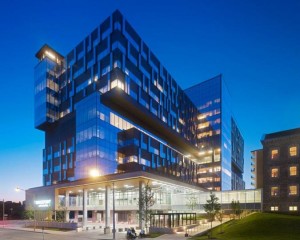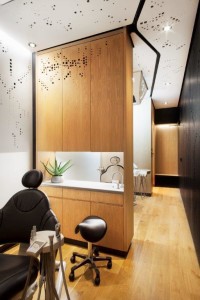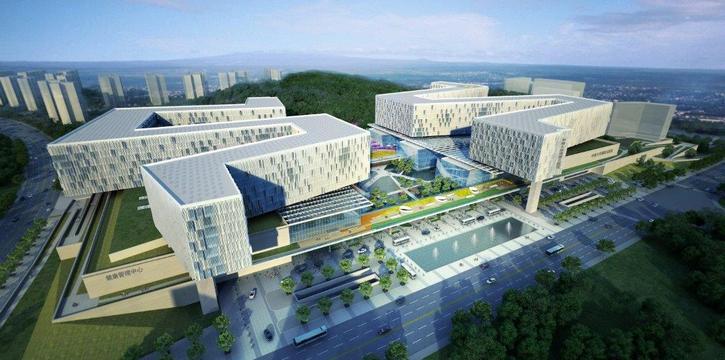 Fifth XiangYa Hospital. Photo courtesy of Payette.
Fifth XiangYa Hospital. Photo courtesy of Payette. 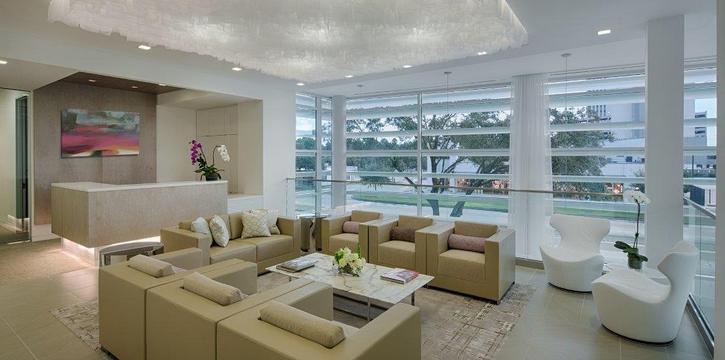 Vitenas Cosmetic Surgery and Mirror Mirror Beauty Boutique. Photo courtesy of Gary Zvonkovic .
Vitenas Cosmetic Surgery and Mirror Mirror Beauty Boutique. Photo courtesy of Gary Zvonkovic . 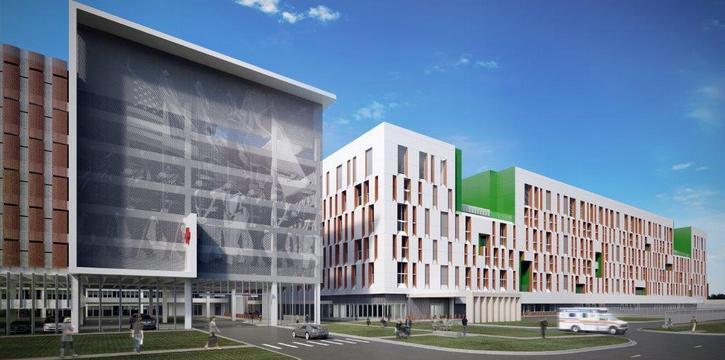 U.S. Department of Veterans Affairs, Robley Rex VA Replacement Medical Center and VBO Office Building.
U.S. Department of Veterans Affairs, Robley Rex VA Replacement Medical Center and VBO Office Building. 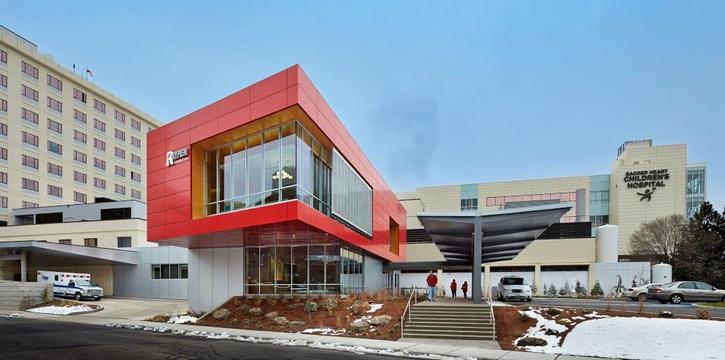 Providence Sacred Heart Medical Center Pediatric Emergency Department. Photo courtesy of Benjamin Benschneider.
Providence Sacred Heart Medical Center Pediatric Emergency Department. Photo courtesy of Benjamin Benschneider. 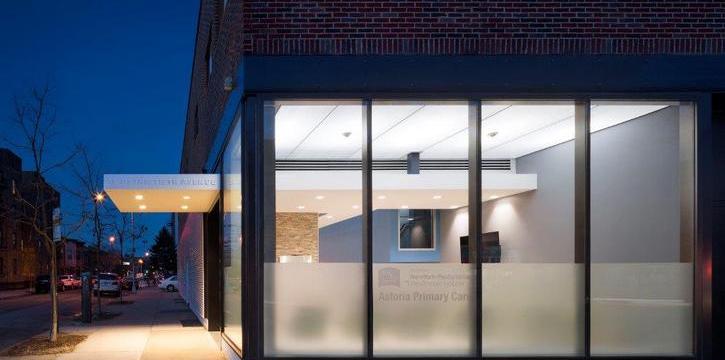 New York Hospital Queens Astoria Primary Care Clinic. Photo courtesy of Alexander Severin/RAZUMMEDIA.
New York Hospital Queens Astoria Primary Care Clinic. Photo courtesy of Alexander Severin/RAZUMMEDIA.  Cleveland Clinic, Brunswick Family Health Center Emergency Department. Photo courtesy of Kevin G. Reeves.
Cleveland Clinic, Brunswick Family Health Center Emergency Department. Photo courtesy of Kevin G. Reeves. Subscribe Now
Eight Projects Selected for National Healthcare Design Awards
The American Institute of Architects Academy of Architecture for Health has selected the recipients of the AIA National Healthcare Design Awards program. The awards showcase the best of healthcare building design and healthcare design-oriented research. Projects exhibit conceptual strengths that solve aesthetic, civic, urban and social concerns, as well as the requisite functional and sustainability concerns of a hospital.
Recipients were selected in four different categories:
Category A: Built, less than $25 million in construction cost
Cleveland Clinic, Brunswick Family Health Center Emergency Department; Cleveland, Ohio
Architect: Westlake Reed Leskosky
This addition to the Cleveland Clinic Brunswick Family Health Center provides a new 22,500-gross-square-foot emergency department at grade, a processing lab, an imaging center, a second-story expansion space of 17,000 square feet intended for future fitout as exam rooms and offices and a rooftop heliport. Compatible with the original structure but easily identifiable as a new component, the project promotes a healing environment of serenity through intuitive wayfinding, resolution in the integration of medical equipment and devices, a strategic placement of art and a strong connection to the natural environment.
Providence Sacred Heart Medical Center Pediatric Emergency Department; Spokane, Washington
Architect: Mahlum
This addition creates a safe, calming environment for young patients in traumatic circumstances. The building’s “emergency red” panels serve as a recognizable focal point on the medical campus, while a light-filled atrium accented by wood and warm colors welcomes visitors arriving from the sheltered drop-off zone. Clinical and public spaces employ graphics, art, comfortable furnishings and inspirational displays to create restorative surroundings. The Kid’s Club overlooks a healing garden, providing refuge and views for patients and their families. Advanced medical care is delivered via central care team zones close to patient care areas. Glass partitions allow visual connections with acoustical privacy.
New York Hospital Queens Astoria Primary Care Clinic; Queens, New York
Architect: Michielli + Wyetzner Architects
This new offsite primary care clinic is one in a series of new neighborhood practices intended to raise the profile of the New York Hospital Queens in the surrounding community. Located in Astoria on a corner site along a busy thoroughfare, the two-story brick building was completely gutted to accommodate new exam and consultation rooms. A perforated metal screen masks the irregular pattern of existing windows on the ground floor, allowing daylight to enter during the day and artificial light to emit a glow at night. An illuminated ceiling is visible through the full-height glass, contributing to the unique presence of NYHQ in the neighborhood. The attention to detail, abundance of natural light and select use of color make this a soothing and sophisticated patient environment.
Vitenas Cosmetic Surgery and Mirror Mirror Beauty Boutique; Houston, Texas
Architect: Harrell Architects, LP
This ambulatory surgery center is squeezed into a tight 19,100-square-foot site that was completely redeveloped. The resulting three-story building reflects the surgeon’s personal style and emulates the quality of his cosmetic surgery practice. The exterior is clad in white metal panels, corrugated zinc panels and white plaster–all accented by the two-story corner “jewel box” window wall. The interiors continue the sleek design of the building exterior with minimal color and crisp detailing that speak of the surgeon’s attention to design. A variety of textures were introduced via the flooring, custom wall panels and drapery. The design puts patients at ease with its elegant palette of materials, furnishings and lighting.
Category B: Built, more than $25 million in construction cost
Bridgepoint Active Healthcare; Toronto, Canada
Planning, Design and Compliance Architects: Stantec Architecture / KPMB Architects
Design, Build, Finance and Maintain Architects: HDR Architecture / Diamond Schmitt Architects
Bridgepoint Active Healthcare is designed to meet the needs of those coping with complex chronic disease. In a setting inspired by nature, rehabilitation is fostered by motivating recovery through salutogenic design that connects with a person’s sense of physical and emotional well-being. From animated public spaces to intimate private ones, Bridgepoint embraces community and landscape. Panoramic views in every patient room, open terraces on the roof, mid-tower and at grade provide broad visual engagement with the surrounding community. These linkages are personalized across the building façade with a seemingly randomized pattern of 472 vertical window projections, each representing a patient.
Category C: Unbuilt, must be commissioned for compensation by a client with the authority and intention to build
Fifth XiangYa Hospital; Changsha, China
Architect: Payette
Located in ChangSha, China in the growing Tianxian district, the Fifth XiangYa Hospital is slated to anchor the developing community adjacent to Xianguling Park. The hospital is connected to the park, both physically and visually. The new 2,500-bed hospital will provide a world-class model for the delivery of healthcare in an integrated, efficient and uplifting environment. Each half of the campus is organized around a central concourse, along which all the clinical functions are organized. The meandering inpatient towers hover above it. Two levels of service functions and parking provide the operational base below ground.
U.S. Department of Veterans Affairs, Robley Rex VA Replacement Medical Center and VBO Office Building; Louisville, Kentucky
Architect(s): URS/SmithGroup JJR Joint Venture
The future Robley Rex VA Medical Center embraces a model of care that embodies healing with honor. By consciously integrating nature with architecture, patients and families will find solidarity and respite in a light-filled concourse, quiet air gardens and elevated courtyards. Each setting offers a unique experience and provides a framework for integrating art, education and support. Designed as a full replacement of the existing building, the facility is planned for 1 million square feet of inpatient and outpatient services and 104 beds, providing north central Kentucky and southern Indiana veterans with easy, timely access to care.
Category D: Innovations in planning and designresearch, built and unbuilt
Studio Dental Mobile Unit
Architect: Montalba Architects, Inc.
Montalba Architects Inc.’s primary challenge was to create a spacious interior, while accommodating Studio Dental’s required program for its Mobile Unit, which travels to businesses offering convenient dentistry. The 26-foot-long trailer with 230 interior square feet features a waiting area, sterilization room and two operatories. The sterilization room is hidden behind millwork panels that wrap around to form the patient waiting bench. A centralized, double-sided millwork panel houses equipment for both operatories and gestures up to 11-foot-plus ceilings with translucent sculpted skylights. The materials reinforce Studio Dental’s identity with natural wood millwork, bright-white surfaces and a custom perforation pattern.
Tags: AIA, Architecture, Awards, Sustainability
Posted August 19, 2015
More Articles:
- Coverings 2024
Apr 22, 2024 – Apr 25, 2024 - Hospital, Outpatient Facilities & Medical Office Buildings Summit
Apr 25, 2024 – Apr 25, 2024 - CxA Workshop & Exam
Apr 29, 2024 – Apr 30, 2024 - EMP Seminar & Exam at CxEnergy 2024
Apr 29, 2024 – Apr 30, 2024 - CxEnergy
Apr 29, 2024 – May 2, 2024 - PHCC West 2024
Apr 29, 2024 – May 2, 2024 - Lean in Design Forum 2024
May 1, 2024 – May 2, 2024








